I've been dreading this development for years, and now it's here. In the new Q50 (which replaces the G37), Infiniti offers the first steering system with no mechanical connection between the steering wheel and the tires. Instead, the steering wheel conveys your instructions to a computer, which in turn sends instructions to an electric motor that turns the front wheels.
Later this year I'll be getting a new Q50 for a week to gain (and report) a more complete and nuanced understanding of the car. Not wanting to wait to find out how much of my dread has been warranted, I borrowed a car from a dealer for a quick test drive.
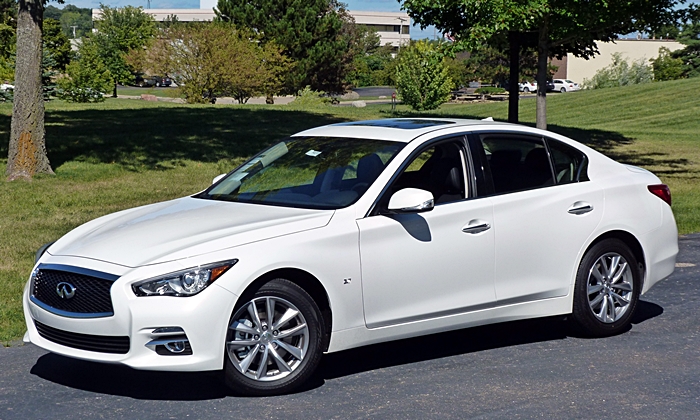
Similar cues, but less striking than the larger Q70. Character line over rear wheel out of place. more Q50 photos

Door panels are especially artful. Seat belt buckle needs an upgrade.
| |
Compared to the IS |
| Handling |
|
Most other reviews of the Infiniti Q37 have been critical of Nissan's "Direct Adaptive Steering." But, asI often tell people, to really know what you'll think of a car you have to drive it yourself.
Nissan claims two advantages. An electronic system can communicate the driver's intentions more quickly than a mechanical linkage can. And the steering ratio can be varied from moment to moment across a broad range, as there's no fixed relationship between the steering wheel and the front wheels. To be specific, while the standard mechanical system has a 16.7:1 ratio, the electronic system can vary the ratio from 11.9:1 to 36.5:1.
Infiniti has opted to provide the driver with three levels of steering effort and quickness."Light and casual" definitely warrants that description. I doubt I'd ever use it. The middle setting feels much like the standard mechanical system, so a little too slow, light, and vague for my taste. I'd likely use it on long highway drives, and perhaps around town.
"Heavy and quick" feels significantly heavier and quicker than any conventional system I've sampled recently, perhaps ever (though some Audi systems come close in their firmness and tight feel, if not their quickness). If you've been seeking a sedan where the car reacts quickly and instantly to the slightest steering input, and where the steering feels tight and direct, you've now found it. I enjoyed the steering with this setting far more than I expected to.
Want the quickness without the heaviness? The middle level of effort can be paired with the quick ratio, for a fourth option.
Despite the lack of a mechanical linkage, feedback is more nuanced and weighting feels more natural than with most current conventional systems. Road surface information is relayed to a third motor, which transmits it to the steering wheel. Tire slip isn't communicated nearly as well, though.
Worried about safety? A mechanical linkage is present, just disconnected in normal operation. If the car loses power or the electrical system fails (despite the presence of redundant computers and motors) the mechanical linkage automatically connects.
Aside from the steering, the Q50 handles much like the G37, though with more refinement (not entirely a good thing). A Cadillac ATS feels more balanced, agile, and precise. The new IS also feels more sporty. To be fair, though, I didn't drive the sport suspended Q50S.
Dip into the Q50's throttle while turning, and the rear end will step out even with all-wheel-drive. With rear-wheel-drive handling probably remains tricky if the stability control is turned off. In the default setting the system continues to cut in too early and too hard. I tapped the button to dial it back just enough to have fun.
| Controls and instruments |
 Better
Worse
Better
Worse
|
American luxury cars usually have touchscreen-based control interfaces. German interfaces tend to be knob-centric. Infiniti must have decided that each approach has its advantages, and equipped the new Q50 with both. Plus a fair number of actual buttons.
The touchscreen mostly serves as the interface for a large number of apps, including the steering and throttle adjustments and a driving performance monitor. The advantage of the second screen: while you're playing with these apps, you can still have your audio or nav information up. In other cars (save the Tesla) you must toggle between them. My computer has three monitors. Why shouldn't my car have at least two?
On the downside, when you first start the car the apps seem to take forever to load. Good thing you have the knob and buttons to do just about everything you need to do. Also, the displays wash out a little in direct sunlight.
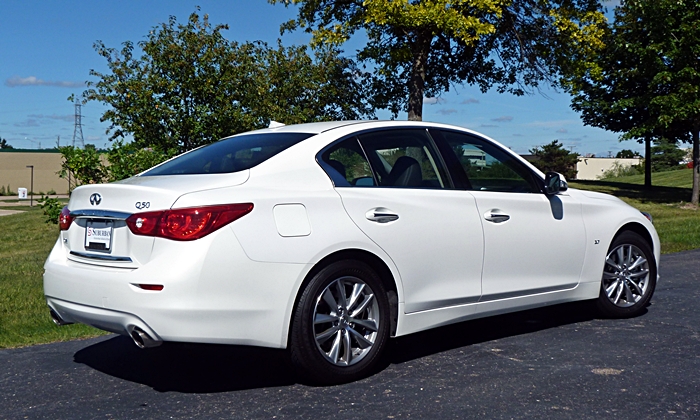
Rear half has less character than the front half.
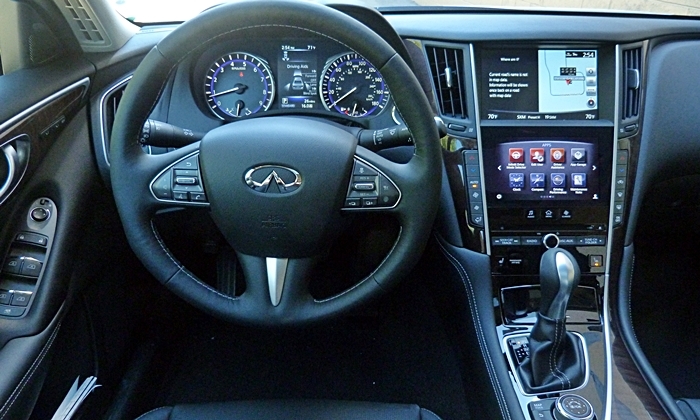
Lower touch screen, upper knob-operated screen.
| Feature availability |
 Better
Worse
Better
Worse
|
Infiniti has been an industry leader in electronic safety systems, and the new Q50 adds predictive forward collision alert and lane keeping assist to the all-speed adaptive cruise control, blind spot monitor, blind spot intervention, lane departure warning, moving object detection, backup collsion intervention, and (still my personal favorite) the around-view camera system.
A growing number of cars offer forward collision alert, which sounds an alarm if you're approaching the car ahead too quickly. Infiniti's new system manages to monitor the car ahead of the car ahead of you.
By combining all of the car's systems with the new lane keeping assist and direct adaptive steering, the Q50 can drive itself on straights and moderate curves.
Beyond safety systems, Infiniti now includes four years of a concierge service. Beyond the usual assistance provided by such services, such as travel and restaurant reservations, this one will attempt to find the answer to any question you might have, about anything.
One major feature is no longer offered, though: if you require a manual transmission, the Infiniti is no longer among your options.
Another highly desirable feature wasn't offered in the G37 sedan, and still isn't in the Q50. If you want a bun cooler, you'll have to buy either the larger, more expensive Q70 or a competitor.
| Price or payments |
 Better
Worse
Better
Worse
|
A base Infiniti Q50 lists for $37,605. Tick all the boxes (including a Sport Package not on the tested car) and the total comes to $53,605.
A similarly loaded BMW 335i lists for $59,175. Adjust for the Q50's additional features (including $1,500 for the world-first steering system, your own valuation may vary), and the gap widens to over $8,000.
Compare the Lexus IS 350, and the picture grows murkier. When both are loaded up, the Infiniti lists for nearly $3,000 more, but includes over $5,000 in additional content. Option the cars with only leather, wood, sunroof, nav, and surround sound audio and the Infiniti lists for $1,305 less than the Lexus, while still including about $1,400 in additional content.
| Rear seat room & comfort |
 Better
Worse
Better
Worse
|
Like the G37, the Q50 has one of the roomiest rear seats among BMW 3-Series challengers. On paper it offers the most combined rear legroom, 44.5 inches in the front seat and 35.1 inches in back, about 2.5 more than the BMW and Lexus. But the difference doesn't seem as large as this number suggests. The Audi S4 and Cadillac ATS remain more cramped. The Q50 doesn't come by its extra room through brilliant packaging. Instead, at 188 inches it's about a half-foot longer than a 3-Series or ATS.
| |
Compared to the IS |
| Exterior styling |
 Better
Worse
Better
Worse
|
I've always had a thing for the original Infiniti G35. In comparison, the second-generation sedan appeared a bit bloated (though the coupe remained a looker). Far from ugly, but nothing special, either. The Q50 looks much like the 2013 G, just with a bolder grille (which isn't to everyone's taste) and a signature piece of wavy chrome on the rear pillar (ditto). When fitted with 20-inch wheels, the larger, curvier M (Q70 for 2014) is both more distinctive and more attractive. As are the Audi, Cadillac, and Lexus. Even the increasingly bland BMW.
| Fuel economy |
 Better
Worse
Better
Worse
|
With EPA ratings of 19 mpg city and 27 mpg highway, the Q50 AWD falls short of the BMW's scores (21/31). But it's on par (or better) compared to the others.
If fuel economy is a priority then the Q50 Hybrid is the way to go, with EPA ratings of 29/36 with rear-wheel-drive and 28/34 with all-wheel-drive. Opt for the S variant and these numbers take a bit of a hit, to 28/34 with RWD and 27/31 with AWD. BMW also offers a hybrid, but not with AWD, and it's not as fuel efficient (25/33).
The Q50S Hybrid costs another $1,850. Quite reasonable, as it's not only more efficient, but also torquier and quicker. More of an issue: it weighs more, which likely impacts handling, and the battery pack reduces trunk volume to a class-trailing 9.4 cubic feet.
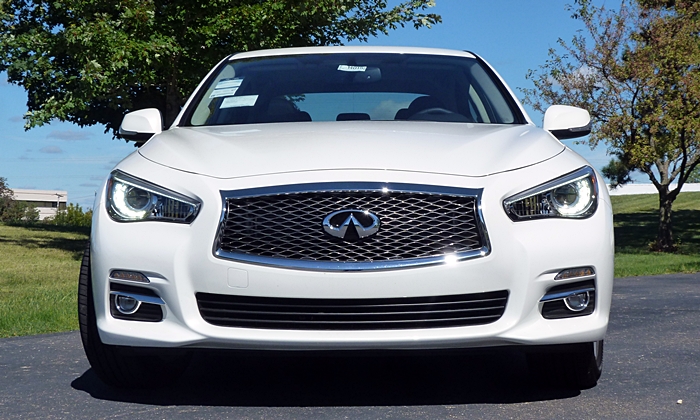
Signature Infiniti grille not to everyone's taste.
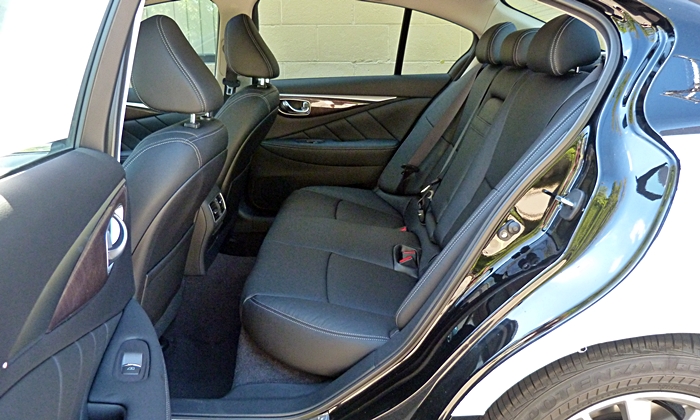
The most legroom in the segment, perhaps because this is the longest car in the segment.
| |
Compared to the IS |
| Interior styling |
|
The Q50's interior is nicer than the G37's, but not as stylish or as well-furnished as the M/Q70's. Compared to the competition, it feels more luxurious than some, but also more conservative (which could be a benefit, depending upon one's taste).
A nit: the seat belt buckle wouldn't pass muster in a Nissan, much less a BMW competitor.
| Front seat support & comfort |
 Better
Worse
Better
Worse
|
The standard Q50's front buckets are fairly comfortable, but provide little lateral support. The S model's sport buckets should fix this issue, especially for the driver, who then gets power-adjustable bolsters.
| Cargo capacity |
 Better
Worse
Better
Worse
|
Trunk volume, at 13.5 cubic feet, is a few cubes short of the BMW, but about even with the Lexus and better than the Cadillac (unless you get the Q50 Hybrid). Unlike in the past, in the regular Q50 a split folding rear seat is available (but not standard or offered as an inexpensive standalone option).
Even without the S model's sport suspension (standard on all Hybrids) and low-profile 19-inch tires, the regular Q50 with its 17-inch tires rides fairly firmly. But so do competitors, especially the Cadillac. I'll more thoroughly evaluate ride quality when I have one for a week.
| Powertrain performance |
 Better
Worse
Better
Worse
|
The regular Q50 retains the G37's 328-horsepower 3.7-liter V6 engine. The big six produces a lower volume of somewhat higher quality noises in the new car. While it might be a match for the V6s in the Cadillac and Lexus, the boosted sixes in the Audi and BMW can blow the others away.
The responsiveness of the Q50's powertrain can also be adjusted, thoughthe differences between the Q50's powertrain modes are much less dramatic than those between its steering modes. Unlike in the Lexus, but like in the Audi and BMW, this adjustment can be made independently of that for the steering. Good move, as "sport" powertrain settings can hold the transmission in a lower gear, to the detriment of fuel economy, ruling them out as a full-time option.
Competitors arguably have more striking or more artful styling, get to 60 (or higher) more quickly, handle more skillfully, or even all of the above. But the Infiniti does just about everything well and includes some intriguing new technology. Most of all, the steer-by-wire system feels much better than anyone expected it to given widespread enthusiast dissatisfaction with electrically-assisted mechanical systems. In its sportiest setting, the Q50's fully electronic linkage delivers a quickness, directness, and heft that conventional systems can't without driving mainstream buyers away. I can sleep again at night.
So, if you're shopping for a car in this class be sure to take a Q50 with the Deluxe Technology Package for a test drive. Most reviewers might not care for the car, but what really matters is what you think.
My own test drive has left me looking forward to my upcoming week with a Q50. At that time I'll also drive a competitor, then update this review.
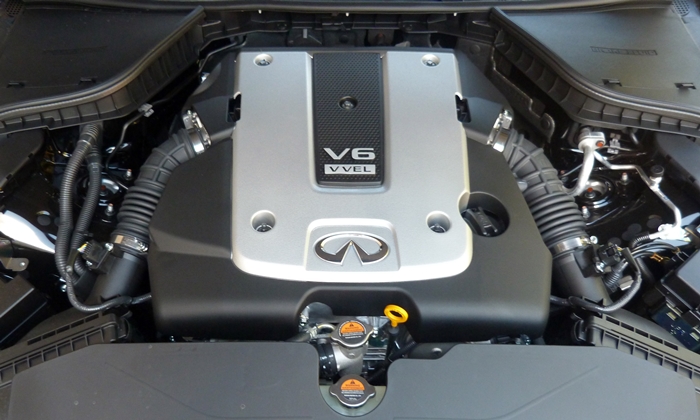
The new car's engine, same as the old car's engine.
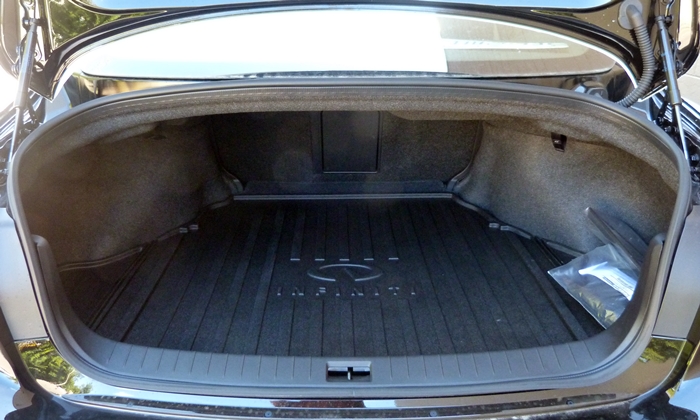
Not as roomy as the rear seat.
See more 2014 Infiniti Q50 photos
Bill French of Suburban Infiniti in Novi, MI, provided a couple Q50s for a test drive. Bill can be reached at 248-427-4712.











